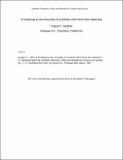A Roadmap to the Assembly of Synthetic DNA from Raw Materials
Author(s)
Sanghvi, Yogesh
DownloadSanghvi Chemical Synthesis.pdf (172.6Kb)
Metadata
Show full item recordAbstract
Until recently, the synthesis of DNA has been a tedious, time consuming, expensive and
experimentally challenging task. But advances in automated instrumentation and
improved chemistry have now made it possible to make any moderate-length sequence of
DNA in any quantity. The ease of automated chemical synthesis of DNA has triggered a
whole new industry of low-cost DNA suppliers around the globe. The convenience of
ordering DNA sequence by mail has opened new avenues in research both in academia
and in the healthcare products developed by pharmaceutical companies. At the same
time, these advances have made it theoretically possible to synthesize DNA that could be
used to do harm. This article aims to describe the first stages of DNA synthesis, from
readily available raw materials to medium-sized segments with a desired sequence
(oligonucleotides), and examines whether there are points at which such activities could
be, for example, monitored or controlled. Some academic and commercial applications of
DNA synthesis require the construction of very small quantities of the desired sequence;
others involve synthesis at the gram scale or larger. I provide comments on possible
intervention points for both types of application. Terms shown in bold are defined in the
glossary.
Description
Technical Report in support of Sloan Foundation study on DNA synthesis and governance options.
Date issued
2007-12-04Department
Massachusetts Institute of Technology. Department of Biological EngineeringCollections
The following license files are associated with this item: